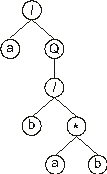GEP genes are composed of a head and a tail. The head contains symbols that represent both functions and terminals, whereas the tail contains only terminals. For each problem, the length of the head h is chosen, whereas the length of the tail t is a function of h and maximum arity n, and is evaluated by the equation:
Consider a gene for which the set of functions consists of F = {Q, *, /, -, +} and the set of terminals T = {a, b}. In this case,
n = 2 and if we chose an h = 15, then t = 16. Thus, the length of the gene
g is 15 + 16 = 31. One such gene is shown below (the tail is shown in
blue):
|
0123456789012345678901234567890 |
|
|
/aQ/b*ab/Qa*b*-ababaababbabbbba |
(2.5) |
It codes for the following ET:

In this case, the ORF ends at position 7, whereas the gene ends at position 30.
Suppose now a mutation occurred at position 2, changing the Q into +. Then the following gene is obtained:
|
0123456789012345678901234567890 |
|
|
/a+/b*ab/Qa*b*-ababaababbabbbba |
(2.6) |
And its expression gives:

In this case, the termination point shifts 10 positions to the right (position 17).
Obviously the opposite might also happen, and the ORF is shortened. For example, consider again gene
(2.5) above, and suppose a mutation occurred at position 5, changing the * into b, obtaining:
|
0123456789012345678901234567890 |
|
|
/aQ/bbab/Qa*b*-ababaababbabbbba |
(2.7) |
Its expression results in the following ET:

In this case, the ORF ends at position 5, shortening the parental ET in two nodes.
It is worth noticing that any mutation occurring downstream of the termination point of a gene is neutral in effect. For instance, the substitution in chromosome
(2.7) of / at position 8 by another symbol, be it a function or a terminal, or the substitution of b at position 16 by another terminal, are examples of neutral mutations. Note that mutations on the tails also occur, but here a terminal can only be replaced by another terminal in order to maintain the structural organization of genes and therefore guarantee their correct expression.
So, despite their fixed length, GEP genes have the potential to code for ETs of different sizes and shapes, being the simplest composed of only one node (when the first element of a gene is a terminal) and the biggest composed of as many nodes as the length of the gene (when all the elements of the head are functions with maximum
arity).
It is evident from the examples above, that any modification made in the genome, no matter how profound, always results in a syntactically correct ET as long as the structural organization of genes is maintained. Indeed, the implementation of high-performing genetic operators in GEP is a childs play, and Ferreira
[7] describes seven: point mutation, IS (from insertion sequence element) and RIS (from root IS element) transposition, two-point and one-point recombination, gene transposition and gene recombination.
|


